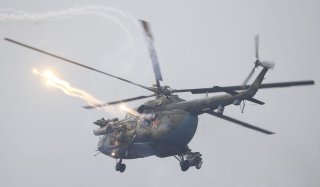Kavkaz 2020 Military Exercise Reveals Russia’s Military Future
One word: Drones.
Here's What You Need To Remember: Swarms of drones gathering and relaying data is not necessarily a new tactical development for some of the world’s top-tier militaries, but it’s something new for Russia.
Russia recently concluded its Kavkaz 2020 military exercise. The annual exercise, which took place from September 21 to September 26, rotates through one of Russia’s four military districts and took place this year in the Southern Military District.
The list of participating countries was decidedly unsurprising. China, Pakistan, Belarus, Myanmar, and Armenia conducted maneuvers with their Russian host, while personnel from Azerbaijan, Indonesia, Iran, Kazakhstan, Tajikistan, and Sri Lanka participated in an observational role. In total, around eighty thousand military personnel participated.
Though not a particularly remarkable as far conventional military exercises go, one of the more standout elements was Russia’s increasingly sophisticated use of drone platforms.
Lots of Drones
Kavkaz may have well been the first time that Russia forces conducted exercises with drone swarms. The exercises saw swarms of small drones employed behind simulated enemy lines and were used to spot and relay target information back to Russian forces. The drones reportedly flew in groups at varying altitudes from one hundred to five thousand meters and were also an “integral element of radio-electronic warfare,” though what exactly that means remains hard to parse.
The Russia Ministry of Defense explained what kinds of drones were used, saying “at the Kapustin Yar training ground [just east of Volvograd, and about 500 kilometers north of Georgia], a combined group of unmanned aerial vehicles . . . was created. It incorporated Southern MD units armed with Forpost drones, Orlan-10s, Eleron-3s and others.”
While the Forpost drone is an Israeli design, both the Orlan and Eleron are indigenous Russian designs. But, unlike their larger American counterparts like the iconic Reaper or Predator drones, they lack the size and flight endurance to carry a substantial weapon payload. They’re essentially hand-held drones. Still, in an intelligence-gathering reconnaissance-style mission, all three drones could play an important role.
Syrian Lessons Learned
Russia could be drawing upon some of the lessons learned from combat in Syria. In that conflict, drones proved to be—and still are—an effective, low-cost insurgency threat. Having been on the receiving end of drone warfare, the Russian military would no doubt like to apply Syrian drone warfare lessons to future combat scenarios.
A Move Towards Drones?
In most respects, the Kazkav 2020 exercises involved a moderate-sized, conventional force and were nothing particularly remarkable. One of the few stand-out elements—groups of drones—is however noteworthy. Swarms of drones gathering and relaying data is not necessarily a new tactical development for some of the world’s top-tier militaries, but it’s something new for Russia. Slowly but surely, the Russian military is moving forward with drones.
Caleb Larson is a defense writer with the National Interest. He holds a Master of Public Policy and covers U.S. and Russian security, European defense issues, and German politics and culture.
This piece first appeared last year and is being reprinted due to reader interest.
Image: Reuters.

